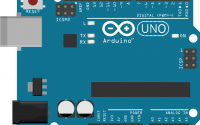Advance Arduino
Advanced Arduino projects are projects that utilize the full capabilities of the Arduino platform to create complex and sophisticated systems. These projects typically require a deeper understanding of the Arduino platform and its capabilities, as well as a more advanced set of skills and tools.

Some examples of advanced Arduino projects include:
- Robotics: Building a robot using an Arduino board, sensors, and actuators. This could include creating a robotic arm, a robot that can navigate autonomously, or a robot that can interact with its environment.
- Home Automation: Creating a system that can control lights, appliances, and other devices in a home using an Arduino board, sensors, and actuators.
- Internet of Things (IoT) Applications: Building a system that can connect to the Internet and collect and transmit data using an Arduino board, sensors, and actuators.
- 3D Printing: Building a 3D printer using an Arduino board and stepper motors to control the movement of the extruder and the print bed.
- Weather Station: Building a weather station that can measure temperature, humidity, and other weather-related data using an Arduino board and sensors.
- Automotive Applications: Building an Arduino-based system to control different functions of a car, such as a GPS navigation system, a speedometer, or a rearview camera.
- Medical Applications: Building an Arduino-based system to monitor vital signs, such as blood pressure, heart rate, and body temperature, or to control prosthetic limbs.
- Drones: Building a drone using an Arduino board, sensors, and actuators to control the flight of the drone.
These are just a few examples of advanced Arduino projects, there are many more possibilities and the possibilities are endless with Arduino. To create one of these projects, you’ll need a solid understanding of the Arduino platform and its capabilities, as well as experience with programming and electronics. Additionally, you may need to use specialized tools and equipment, such as a 3D printer or a soldering iron.
Another advanced Arduino project that can be undertaken is building a quadcopter. This project involves using an Arduino board to control the movement of the quadcopter’s motors and to stabilize its flight. The project requires knowledge of aerodynamics and physics, as well as experience with programming and electronics. It also requires specialized equipment such as electronic speed controllers, accelerometers, and gyroscopes.
Another advanced project is building a 3D scanner using an Arduino board and a laser diode. This project involves creating a system that can scan an object and generate a 3D model of it. The project requires knowledge of computer vision and image processing, as well as experience with programming and electronics. It also requires specialized equipment such as a laser diode, a webcam, and a servo motor.
A project that is becoming increasingly popular is building a smart mirror using an Arduino board and a touchscreen display. This project involves creating a mirror that can display useful information such as the time, weather, and news, as well as allowing the user to control home automation devices and access the Internet. The project requires knowledge of user interface design, as well as experience with programming and electronics.
An advanced Arduino project that can be undertaken is building a portable oscilloscope using an Arduino board and an OLED display. This project involves creating a portable oscilloscope that can measure and display electronic signals, such as voltage and current. The project requires knowledge of electronic circuit design, as well as experience with programming and electronics. It also requires specialized equipment such as an OLED display and an oscilloscope probe.
These projects are just a few examples of the many advanced Arduino projects that can be undertaken. They demonstrate the wide range of capabilities of the Arduino platform and the many different fields in which it can be applied. To undertake one of these projects, it is important to have a solid understanding of the Arduino platform and its capabilities, as well as experience with programming and electronics. Additionally, specialized equipment and tools may be required.



